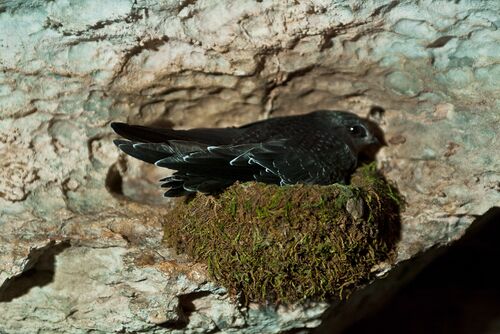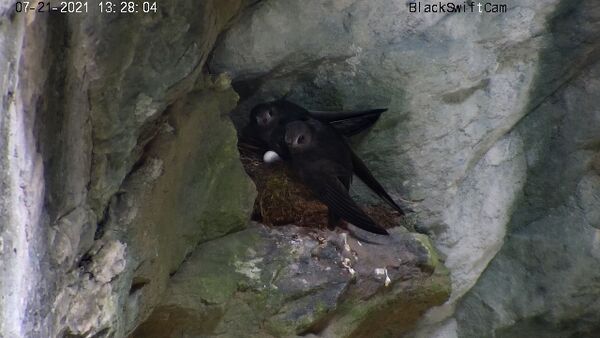Black Swift
The photo on the left shows a well-developed Black Swift nestling on its moss nest at Fulton Resurgence Cave, Colorado 8-30-2004 (photo courtesy of Todd Patrick Photography). The photo on the right shows adult male and female Black Swifts and their single egg at their nest at Box Canyon Falls, Ouray, Colorado 7-21-2021 (photo taken by Carolyn Gunn/Black Swift Cam).
The Black Swift is a long-distance migrant, traveling about 4,300 miles (7,000 km) each year from the State of Amazonas in Brazil to North America to breed at waterfalls (and a few caves). These swifts show strong nest-site fidelity, returning year after year to the same waterfall and even the same nest. They arrive in Colorado in late May or early June, roosting at their nest at night and foraging on the wing for aerial insects during the day. During this time, they build or repair their nest and lay a single egg in late June or early July. Their incubation and nestling period is unusually long, extending into September and sometimes October. Throughout the nestling period, both adults forage for aerial insects, store them in their throat, and return to the nest to feed the chick. When the chick becomes capable of flight, it and both adults leave the nest and begin their long return journey to Brazil. Migration and breeding are an enormous expenditure of energy in order to raise just a single chick each year. The Black Swift faces many challenges during its life cycle, including climate change, dewatering of streams supplying waterfalls, steep declines in their aerial insect prey, and habitat degradation.
The Black Swift ranks among North America’s most specialized and sensitive cliff-nesting birds. However, recreational canyoneers are increasingly putting pressure on the remote, vertical locations that have sheltered and protected Black Swifts for millennia. Canyoneers descend mountain canyons with flowing water—a sport known as canyoneering or canyoning—by climbing, jumping, rappelling, walking, and using other techniques. Once only practiced by avian researchers and extreme sports enthusiasts, the activity has expanded rapidly as standardized safety and rating systems emerged, guiding and support organizations became professionalized, equipment modernized, and the Internet made information widely accessible. Yet, sport activities can damage these fragile canyon and waterfall environments, especially the flora and fauna that live in cliff and waterfall habitats.
However, in Colorado, observers are increasingly documenting this activity through evidence such as expansion bolts and clips at waterfalls, abandoned ropes dangling from cliffs, and direct encounters and conversations with canyoneers. Publicly editable websites like RopeWiki provide step-by-step instructions on how to locate, approach, and descend many waterfalls worldwide, making these sites accessible to anyone.
Canyoneers and waterfall rappellers increase pressure on these fragile habitats in many ways. They flush adult birds from nests, causing nest abandonment and leaving eggs or hatchlings exposed to heat, cold, and death. Their repeated disturbance stresses and injures adult birds, exposes eggs and nestlings to predators, and reduces breeding success through stress, abandonment, or direct damage to eggs, young, and nests. By forcing adults to stay away from nests longer, they reduce feeding rates for nestlings. When storms occur, they flush adults from protective cover. They displace nesting or potentially nesting birds, forcing them to search for new sites—something especially harmful to Black Swifts, whose limited nesting niches often coincide with canyoneering routes.
Canyoneers also alter the microhabitats that Black Swifts depend on for nest concealment and humidity control. Rappelling ropes can block specific flight paths, making it difficult for birds to access nests or feed their young. Climbers may inadvertently damage or dislodge nests, and because Black Swifts reuse nests for years, such damage can permanently destroy a breeding site. Canyoneering gear can also injure birds that collide with or become snagged by ropes and equipment. These disturbances severely impede Black Swift reproductive success, since the birds lay only a single egg each year; if a breeding attempt fails, the pair must wait until the next season to try again.
Canyoneers and land managers can take several actions to mitigate disturbances to Black Swifts. They can establish voluntary restrictions or prohibit canyoneering and rappelling near known or suspected nesting waterfalls from early June through mid-September to protect swifts during the nesting season. Guide services and canyoneering organizations can implement voluntary seasonal closures to reduce disturbance and help prevent the need for stricter legal protections. Managers can create buffer zones at least 50–100 meters from active nests and ensure that canyoneers avoid rappelling directly over or behind waterfalls known to host swifts. Participants can reduce shouting that echoes within canyons. Land managers can install interpretive signs explaining seasonal closures and develop websites that describe Black Swift ecology. They can encourage canyoneers and climbers to report Black Swift sightings to eBird and to state or federal wildlife agencies. Agencies such as the U.S. Fish and Wildlife Service, U.S. Forest Service, Bureau of Land Management, and state wildlife agencies can include waterfall-nesting bird protection measures in management plans. These agencies can also develop permit systems for technical canyon routes and include seasonal restrictions and protective conditions in special-use or outfitter permits.
The Migratory Bird Treaty Act (MBTA) protects the Black Swift by prohibiting any damage to active nests, eggs, or chicks of most migratory birds and by making it illegal to “take” them without a permit. The Act forbids anyone from destroying an active nest and requires permits for any activity that would disturb or remove a nest containing eggs or young. The U.S. Forest Service and U.S. Fish and Wildlife Service designate the Black Swift as a Species of Special Concern. Partners in Flight, an international bird conservation organization, classifies the Black Swift as a species of Continental Concern. Breeding Bird Survey data show that the Black Swift population has declined sharply—by as much as 94% since 1970. The International Union for Conservation of Nature (IUCN) Red List also classifies the species as Vulnerable. In Canada, the federal government listed the Black Swift as Endangered under the Species at Risk Act in 2019, following the Committee on the Status of Endangered Wildlife in Canada’s 2015 designation of the species as endangered. In Colorado, biologists rank breeding Black Swifts as vulnerable because they are rare and uncommon, occur in a restricted range, or face other threats that increase the risk of extirpation or extinction. The State of Colorado also designates the species as one of Greatest Conservation Need due to its declining population trend.

